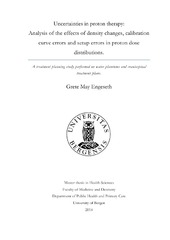Uncertainties in proton therapy: Analysis of the effects of density changes, calibration curve errors and setup errors in proton dose distributions. A treatment planning study performed on water phantoms and craniospinal treatment plans
Master thesis
Permanent lenke
https://hdl.handle.net/1956/8189Utgivelsesdato
2014-05-15Metadata
Vis full innførselSamlinger
Sammendrag
Aim: To analyse the dosimetric effects of density changes, calculation curve errors and geometric errors in proton dose distributions. Methods: Single field optimized treatment plans were created on homogenous and heterogeneous water phantoms. Intensity modulated craniospinal treatment plans were created on CT image data sets from 6 pediatric patients. Setup errors were simulated by shifting the isocenter for ±1 to ±5 mm along the x-, z-and y-axis. Calibration curve errors were simulated by increasing or decreasing the relative stopping power by 1% to 5%. Density changes were simulated by introducing bone and air in the beam path. Result: Air and bone resulted in a change in proton range with a factor of +0,94 and – 0,48, respectively. The V95% was >97% for the CTV regardless of any setup-and calibration curve error, though hotspots and cold spots occurred in the brain. A 3% overshoot caused an increased of 47% in the Dmean for the thyroid. Conclusion: Density changes caused severe alterations of the proton range. Error-induced dose disturbances emerged mainly in areas of complex tissue heterogeneities. Following setup-and calibration curve errors, significant dose escalation were observed for organs at risk in close proximity to the target volume.
